The first sign we were getting close was the smell.

Gorilla pee is not the most attractive of aromas, but if you smell it, you know you’re very close. We’d left our bags in a clearing and were proceeding in silence along a narrow path through a bamboo thicket, the sky obscured by its thick fronds. Carrying just our cameras, ready to shoot on sight, all eight of us were a little nervous. A sudden thrashing immediately above my head sent my pulse leaping. I thought I was about to get a gorilla literally drop on top off me.
But he didn’t penetrate the canopy, crashing off noisily to our right somewhere. Within moments though, we found Gukonda, the park’s largest silverback - all 120 kilos of him. Officially you’re not supposed to get closer than seven metres, but the only way past was the trail we were walking on. Which took us within a metre. He looked on serenely as first we went slightly crazy with our cameras and then we crouched, dumbfounded, eyeball-to-eyeball with this almost motionless giant - all huge, dark disdainful eyes, vast black hands and thick hairy shoulders.

My first encounter with the gorillas, was not my first with Rwanda.
I lived here for a year in 1987 as an 18-year-old volunteer teacher. In those days no one had really heard of the place. The gorillas were the sole tourist attraction, few people visited them. How things have changed. In ways I could never have imagined. The gorillas remain and now rank as one of the ultimate wildlife encounters in the world. And the whole world knows about Rwanda – the awfulness of the genocide has ensured that. These twin themes – gorillas and genocide - tend to be what writers focus on. But whilst they offer very moving and thought-provoking experiences for visitors there’s far more to this part of East Africa.
Currently, many tourists just come to see the gorillas and maybe visit the excellent and profoundly moving Genocide Memorial Museum on the way back to the airport. I wanted to find out what else there is to see – not just in Rwanda but across the border in neighbouring Burundi too. My journey took me from the Volcanoes National Park in the far north of Rwanda, south to the ancient royal capital of Nyanza and the primeval rainforests of Nyungwe National Park and ended on the shores of Lake Tanganyika close to Bujumbura, the capital of Burundi.
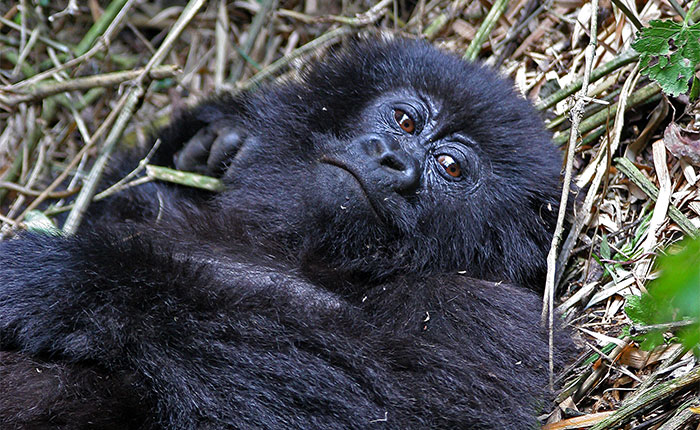
Volcanoes National Park itself has more to offer than gorillas. Next morning I was up early again to hunt for a much smaller endangered primate. Golden Monkeys are only found here and across the borders in adjoining national parks in Congo and Uganda. If it wasn’t for their bigger cousins, they’d be stars of the wildlife show. We picked our way around local farming plots before crossing into the national park and trekked about an hour along squelchy trails skirting fresh piles of wild buffalo dung.
Whilst the gorillas had been pretty disinterested in us, the monkeys were curious and playful, bright bundles of gold and black fur clattering through the bamboo. We spent a fascinating hour surrounded by them. There were eight people in our group just as for the day before, but whereas with the gorillas we’d had to stick together for safety reasons, here we could roam freely, find our own spot and just watch. It was a very different experience and in some ways, more rewarding.

One of the reasons primates have fared relatively well in this part of Africa is that locals don’t eat them. There’s no bush meat culture in Rwanda. But monkeys and gorillas used to get caught by mistake. That afternoon I met 66-year-old Leonidas at Iby’Iwacu Cultural Village. He along with many of the community used to make a living illegally trapping wild game in the national park - sometimes snaring baby gorillas by mistake. Now the former poachers demonstrate crafts and traditions, like blacksmithing and concocting scary witchdoctor potions, in a mock-up of a traditional village complete with king’s huge round straw hut.
Leonidas had the hugest smile and the most remarkable lack of teeth, but he was a dab hand with a bow and arrow. He tried to teach me, but I was hopeless. Whilst I failed to hit the target at 10 feet, he in his time had killed over 200 antelope and 15 water buffalo using bow and arrow and snares. The afternoon concluded with the whole village thumping out tribal rhythms on huge drums, dancing warrior dances bedecked in swirling headdresses. A rhythm-free Brit in a hiking boots and kagoul, I felt about as self-conscious as you can get when they dragged me up to join in. But to my surprise, I thoroughly enjoyed it. Rwandans love to sing and dance. Their joy was utterly infectious.
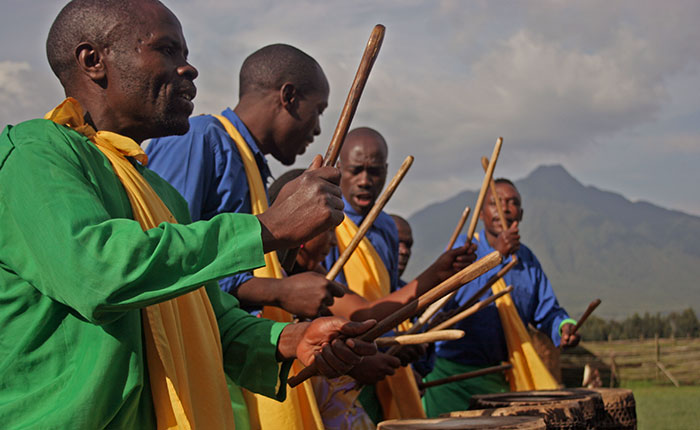
Rwanda is a republic, but it has a long history of monarchy and I found some real regal residences in Nyanza, which was once the seat of Rwanda’s kings or Mwami. The penultimate king, Mwami Rudahigwa Mutara III, built two palaces here and they’re now museums. At the Rukali Palace Museum, his colonial-era palace is a time capsule of African Art Deco fireplaces and furniture and walls bedecked with faded prints of pit-hatted, moustachioed Belgians and grim Catholic clergy sat next to stern-looking Rwandan kings in animal skins. Mutara III also had a more modern palace built nearby. Today the Rwesero Palace houses the Rwanda Modern Art museum. Tribal huts used to be decorated with intricately patterned mud collages painted with bright dyes, but these skills were disappearing. Recently though, there’s been a renaissance in the creative arts, including the re-establishment of an Arts School at Nyundo nearby. The originality of the pieces was brilliant: wildly colourful sculpture, acrylics, collages and more.
Read more > Elephant trekking in Sri Lanka
Butare in the far south proved the perfect place to kick back for a day or so. The country’s university town, it’s a one-strip town with a sleepy feel. Locals joke that if assassinated former president Habyalimana returned from the dead, he’d come here because, unlike much of the rest of the country, little has changed in Butare. I supped excellent Rwandan coffee in a funky café and browsed for souvenirs at a local art cooperative stuffed with baskets and carvings. In the evening I munched pizza and drank chilled beer on the terrace of The Ibis, the town’s oldest hotel. It didn’t look like it had changed since colonial days. Set right on the main strip, it was ideal for people-watching.
Butare might be in a bit of a timewarp, but in many places in Rwanda you can really sense the momentum. A new generation of smart, predominantly English-speaking Rwandans – many returned exiles - is making ambitious development plans. Tourism is an integral part of the mix. Nyungwe National Park, several bumpy hours west of Butare, is a great example. This chunk of preserved medium-altitude rainforest is roughly the size of Hampshire and it’s stuffed with species – orchids, birds, primates and reptiles.
I met Kambogo Ildephonse, the Head Tourism Warden there a few days later to continue my quest for rare primates. The park is home to around 500 chimpanzees and a couple of groups have been habituated, making it possible to be fairly sure you’ll see them. We were up very early, bumping along in a 4x4 for an hour, watching dawn leak its light slowly into the steep, cloud-strewn valleys. “At present the park can only be visited on guided treks,” he told me, “but we plan to introduce self-guided trails later this year.”
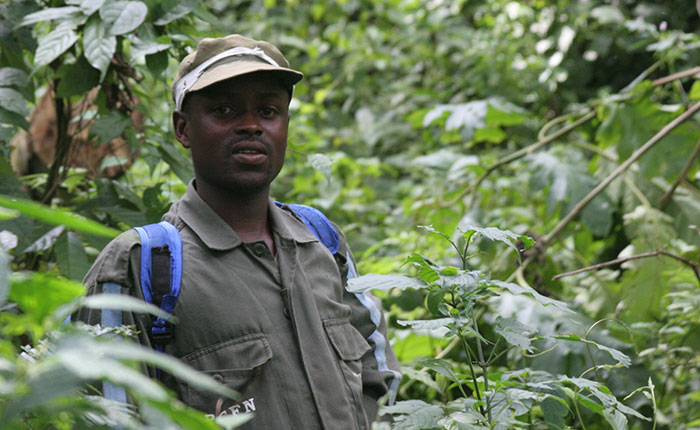
The hike to reach the chimps was short but intense. Kambogo set off up a steep pathway through the jungle. I immediately struggled to keep up, my heart thumping. Rainforest mulch is slippery underfoot. I grasped at creepers. They wobbled and swayed offering no purchase. By the time we crested the hill, sweat was dripping from my forehead. “We’re at 2600 metres,” Kambogo smiled. (That might explain it. Nothing whatsoever to do with being unfit.) Kambogo checked in with the trackers on his radio. “The chimps are on the move. We’ll wait here and leave the trackers to do the chasing,” he said. Good idea.
Twenty minutes later, Kambogo’s radio crackled to life. Time to move. Now it was downhill - hard to keep your feet. I opted to hurtle forward, grabbing at trunks to avoid running out of control down the slope. We halted, and with the most gentle of rustles, a tracker materialised from the foliage. We followed him to the side of a steep hill and an opening in the canopy. At first I couldn’t see anything, then the leaves of a huge fig tree about 50 metres away shook and rustled and a dark hairy head and shoulders appeared. We sat and watched, hoping the chimps would come closer, but they kept their distance, too interested in the figs high above us.

Protecting rainforest is no easy task. In the afternoon, I visited a newly constructed village for a local Ba’twa pygmy tribe who’d previously lived inside the forest - a line of mud huts with shiny new corrugated iron roofs. Chattering kids crowded round us, shy and curious at the same time. A couple of women sat on a straw mat smoothing the surfaces of part-made mud pots, using small pieces of plastic as spatulas.
We met Antoine one of the elders. I asked how he felt about the move. “We’re very happy to be in modern houses with roofs that don’t leak,” he smiled. The idea is that selling pots to tourists will provide income to offset the loss of valuable hunting territory. I ask if they are hungry, noting the protruding bellies of several younger children. “This is a big problem,” he said. “Before we had far more land, now we are struggling to grow enough food.” “Part of the problem is lack of tourists,” Kambogo explained. “Not enough people visit, so they don’t sell enough pots. Another issue is they don’t understand how to handle money. As soon as they have it, they just spend it.”
We took a rain-spattered walk next day along one of Nyungwe’s forest trails and watched a huge troop of Colubus monkeys thrash through the tree tops, flashes of black and white bouncing from branch to branch. Perhaps the clearest demonstration of Rwanda’s ambitions for tourism is a new high level aerial walkway here. Built using state-of-the-art steel, nylon and plastic at a cost of close to a million US dollars, it offers a swooping, vertiginous walk between centuries-old trees 90 metres above the ground.
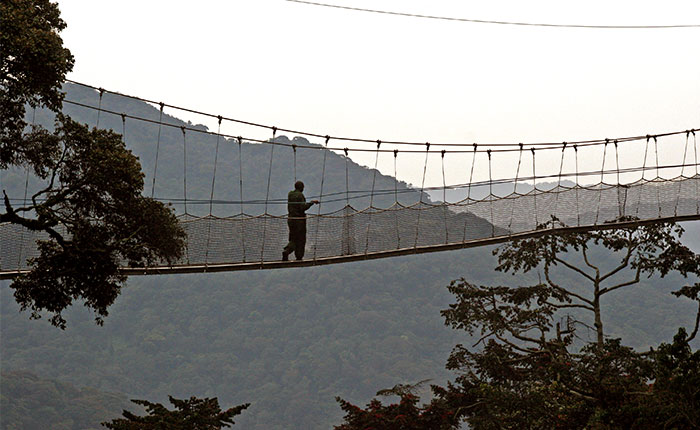
During the distant days of colonial rule, Rwanda and its neighbour to the south Burundi were defined as a single country – Ruanda-Urundi. Whilst everyone knows about Rwanda, little about Burundi makes the Western media. It’s a blank space on the tourist map, just waiting for exploration. In my passport I carried a full-page visa for Burundi. It was time to use it.
I’d been staying at the Nyungwe Forest Lodge, a stylish new lodge set in a scenic tea plantation on the outskirts of the forest and they were kind enough to provide a driver to take me to the border. We left Rwanda with its brand new customs office and headed through no man’s land to Burundi. Here a battered rag of a flag hung limp on the flag pole. I waited ten minutes whilst someone went to find the border guard to stamp my passport. He scrutinised it for what seemed like an age before stamping it. “Bienvenue au Burundi,” he smiled.
Read more > Exploring Kenya's mysterious coast
Christian my guide welcomed me to Burundi too and we set off, heading south for Bujumbura the capital. The roads were in surprisingly good condition. Under the hot equatorial sunshine the reds, yellows and blues of people’s clothing were ultra-bright. Bicycles wobbled by, their riders almost obscured by the vast loads of sugarcane and jerrycans strapped to them. There was a breeze ruffling my hair through the open window. It felt exciting to be in uncharted territory.
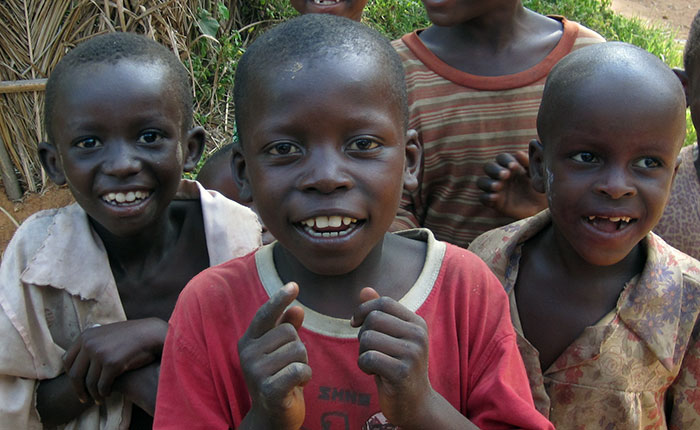
‘Buja’ as the locals call it does not have many tourist attractions. Most of the sights were faded monuments to people no one outside the country has heard of guarded by bored policemen - who would not on any account let me take pictures. But it was Saturday and I’d been reliably informed that what Buja lacks in sights it makes up for with nightlife. I headed for Havana bar on the strip of bars in the centre. My timing was perfect. Burundi’s hottest souk band Kidum were on stage. 10,000 Burundi Francs on the door got me inside. It was hot, it was heaving. By the end of the night I’d got the Buja boogie sorted. Waggle your bum, hunch your shoulders, rotate wrists, grin like you head’s going to drop off. Easy.
The downside to doing a trip to East Africa to see wildlife is mornings. They’re always early. And at 8am next day, feeling just a little jaded, I was rocking in more gentle manner on a small boat on the riverside at Rusizi National Park outside the city. The sun was already intense in a cloudless sky, but thankfully there was an awning above my head and I’d remembered my sunglasses.

Etienne our guide had a gnarled face and tombstone teeth. He told me - in French - that he’d been guiding in Rusizi for 15 years. “You still see crocodiles,” he said, “but they are rare now.” He was sharp when it came to spotting birds. And there were masses - weavers, ibis, spoonbills, flamingos, plovers, lapwings and storks flapped and fluttered in front of us. And hippos too. A fat happy family wallowed on a sandbank, hippo-kids looking on with childlike curiosity. “We don’t go too close, when they have babies,” Etienne explained. “Hippos can be pretty unpredictable.”
We come quite suddenly to Lake Tanganyika. The vastness of the water was a surprise after the enclosed banks of the river, its scintillating blue surface a complete contrast with the brown gloop of the river. Somewhere in the distance I could make out the hazy shores of the Congo; in between a fisherman poled his boat slowly across the water. It was a scene of complete serenity, a scene that had probably not changed in decades. I decided Rwanda and Burundi seemed like a pretty ideal combination really: the frisson of the untamed and unexplored with the excitement of progress - wrapped up in a bundle of dazzling sunlight.
Fancy a Rwanda holiday?
Get There: Fly to Kigali and Bujumbura via Brussels with Brussels Airlines or via Amsterdam with KLM.
Stay There:
Nyungwe NP: Nyungwe Forest Lodge offers stylish bungalows with terraces looking straight onto the rainforest and designer bathrooms. There’s an infinity swimming pool, treatment rooms for spa massages, and large lounge with open fire, wide rainforest views and books for browsing.
Volcanoes NP: Sabyinyo Silverback Lodge is the most luxurious of the gorilla trekking lodges with cosy bungalows which exude a atmospheric colonial-era vibe with open fires and chunky wooden furniture.
Kigali: The Serena Kigali
is the city's only 5 star hotel. The cool, spacious, comfortable rooms overlook a freeform tree-fringed swimming pool with cascading water fountains, perfect for relaxing away from the bustle of the city.
Bujumbura: Four star La Palmaraie is a short drive from the town centre and has comfortable rooms beside an attractive pool and a pleasant restaurant. Probably the nicest hotel in Buja.
Do The Tour: Many Africa experts offer trips to Rwanda. Rainbow tours has a tour that includes Nuyngwe as well as the gorillas. Burundi is much harder to get to but Undiscovered Destinations do offer tours there.